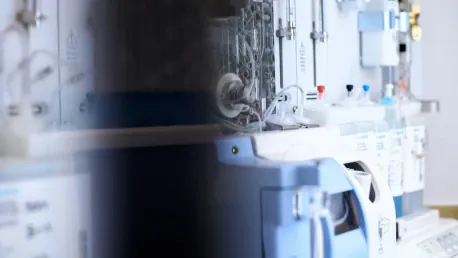The global market for smart medical devices is on a trajectory of rapid growth, projected to soar from USD 172 billion in 2023 to an astonishing USD 474 billion by 2032. This remarkable expansion, driven by a compound annual growth rate (CAGR) of 12.3%, underscores the transformative impact of technology in healthcare. Innovations like artificial intelligence (AI) and wearable health devices are fueling demand for real-time health monitoring and personalized healthcare solutions, creating a dynamic and evolving market landscape.
Technology’s fusion with healthcare is exemplified by the diverse array of smart medical devices now available. From smartwatches to AI-enabled diagnostic tools, these devices enhance patient care by providing real-time health monitoring, chronic disease management, and personalized healthcare. They leverage features such as data connectivity, IoT integration, and AI-driven insights, revolutionizing medical practice.
Market Valuation and Growth Projections
Anticipated Growth and Market Size
The smart medical devices market is witnessing tremendous growth. With a projected increase from USD 172 billion in 2023 to USD 474 billion by 2032, the market is set for an impressive expansion. This substantial leap is driven by a robust compound annual growth rate (CAGR) of 12.3% over the forecast period. Such robust projections reflect the increasing adoption of advanced technologies in healthcare, which are not only enhancing diagnostics, treatment, and patient engagement but also playing a crucial role in cost management and operational efficiencies.
As the world becomes more digitally connected, the integration of smart technologies into healthcare systems continues to provide improved outcomes for patient care. The rapid transition towards digital health solutions and a growing emphasis on preventive care measures are key contributing factors to this monumental market growth. This transformative journey is characterized by innovations that cater to personalized healthcare, offering precise and prompt medical insights that are reshaping the future of medicine.
Technologies Driving Market Expansion
Artificial intelligence and wearable health devices are at the forefront of this market’s growth. AI, in particular, is revolutionizing patient care and research by enabling smarter diagnostics and personalized treatment plans. Through sophisticated algorithms and machine learning capabilities, AI technology is setting new benchmarks in the accuracy and efficiency of medical diagnostics. Wearable health devices like smartwatches and fitness trackers provide continuous health monitoring, offering critical data on heart rate, physical activity, and other vital metrics, further boosting market demand.
These technologies offer a seamless connection between patients and healthcare providers, enabling real-time monitoring and timely medical intervention. The convenience and proactive health management provided by these devices are aligned with the emerging trend of consumer-driven healthcare. This paradigm shift is towards empowering individuals with tools for maintaining and improving their health, ultimately driving the growing demand for smart medical devices.
Technological Advancements
The Role of Artificial Intelligence
Artificial intelligence (AI) plays a pivotal role in the advancement of smart medical devices. AI technology enhances patient care by providing smart diagnostics and personalized treatment options. Through machine learning algorithms and predictive analytics, AI-driven devices can quickly analyze vast amounts of health data, facilitating early disease detection and improving clinical outcomes. By incorporating AI, medical devices can offer superior predictive capabilities, making it possible to anticipate health issues before they become severe, thereby enhancing preventive care.
AI’s integration into smart medical devices helps healthcare providers make more informed decisions, resulting in better patient care and resource allocation. The ability of AI to process and interpret complex medical data in real time underpins its transformative impact on various aspects of healthcare. From analyzing medical images with unparalleled precision to offering virtual health assistants capable of providing round-the-clock support, AI is undeniably a game-changer in the medical devices market. As these capabilities continue to evolve, we can expect even more sophisticated applications that will further revolutionize healthcare delivery.
Emerging Innovations in Wearable Health Devices
Wearable health devices are continuously evolving, offering advanced features that cater to modern healthcare needs. Devices such as smartwatches, fitness trackers, and continuous glucose monitors are becoming increasingly sophisticated. They monitor various health metrics in real-time, including heart rate, physical activity, sleep patterns, and blood glucose levels. These advancements allow for continuous monitoring, promoting healthier lifestyles and providing essential data for managing chronic conditions like diabetes efficiently.
The growing consumer interest in health and wellness is driving the adoption of these devices. Wearable technology is no longer just about fitness tracking; it includes features for monitoring mental health, stress levels, and even detecting irregular heart rhythms. These comprehensive health insights empower individuals to take proactive measures towards their well-being. The continued innovation in wearables, combined with the integration of AI and IoT, is expected to yield even more personalized and predictive health solutions. This trajectory indicates that wearable health devices will remain a cornerstone in the evolution of smart medical technologies.
Market Drivers and Barriers
Factors Fueling Market Demand
Several factors fuel the growing demand for smart medical devices. The need for real-time health monitoring and the shift towards personalized healthcare are primary drivers. Consumers are seeking tailored healthcare solutions that cater to their specific needs, leading to increased adoption of smart medical gadgets. Additionally, the burgeoning interest in fitness and wellness is propelling the popularity of wearable devices, which encourage healthier lifestyles through constant activity tracking and health metrics monitoring.
Another critical driver is the aging population, which is more susceptible to chronic conditions requiring constant monitoring. The convenience and non-invasive nature of smart medical devices make them particularly appealing for elderly patients. The increasing reliance on telehealth services, especially during the COVID-19 pandemic, has also highlighted the importance of remote monitoring capabilities. These trends collectively contribute to the accelerating demand for innovative medical technologies, making them integral to the modern healthcare landscape.
Challenges Facing the Market
Despite the promising growth, the smart medical devices market faces significant challenges. Data privacy is a major concern, given the vast amounts of personal health information collected by these devices. Ensuring the security and privacy of this data is crucial, as is maintaining regulatory compliance to meet safety and efficacy standards. Navigating these challenges requires stringent data protection measures and adherence to regulatory guidelines to safeguard user information and build consumer trust.
The regulatory landscape for medical devices is complex and constantly evolving. Companies must stay abreast of regulatory changes and ensure their products meet the necessary standards for safety and effectiveness. Additionally, the high cost of advanced smart medical devices can be a barrier to widespread adoption, particularly in developing regions. To overcome these challenges, continuous innovation, collaboration with regulatory bodies, and transparent communication with consumers about data protection strategies will be essential.
Regional Market Insights
North America’s Dominance
North America leads the global smart medical devices market with a 42% share. This leadership is attributed to advanced healthcare infrastructure, a higher rate of technology adoption, and favorable government initiatives supporting healthcare innovations. The region’s robust ecosystem of research and development, combined with significant investment in healthcare technologies, continues to drive market growth and maintain its leading position. North America’s healthcare sector is characterized by a strong emphasis on precision medicine and digital health solutions, both of which are driving the demand for smart medical devices.
The region’s focus on innovation is further supported by a plethora of startups and established technology companies working in the space of digital health. Collaborations between tech giants and healthcare providers are common, fostering an environment that encourages continuous improvement and adoption of smart medical devices. Additionally, with a population that is increasingly health-conscious and technologically adept, North America is poised to remain at the forefront of this market’s growth.
Emerging Markets and Growth Opportunities
Emerging markets across Asia-Pacific and Europe present significant growth opportunities. Increasing healthcare awareness, rising disposable incomes, and growing adoption of healthcare technologies in these regions are contributing to market expansion. Countries like China and India are investing heavily in healthcare infrastructure, making them potential hotspots for future growth in the smart medical devices market. These regions are also seeing a rise in the prevalence of chronic diseases, further driving the demand for advanced healthcare solutions.
Additionally, government initiatives aimed at improving healthcare access and affordability are providing a fertile ground for the adoption of smart medical devices. With large and diverse populations, the potential for scalable healthcare solutions in these markets is substantial. Local companies are increasingly collaborating with international firms to bring cutting-edge technologies to their respective markets. This trend not only facilitates knowledge transfer but also ensures that the smart medical devices market remains dynamic and inclusive of various demographic needs.
Trends Shaping the Future
IoT Integration in Healthcare
The integration of the Internet of Things (IoT) in smart medical devices is revolutionizing healthcare delivery. IoT-enabled devices enhance connectivity, creating comprehensive health ecosystems that improve patient care coordination and data sharing across various healthcare platforms. These ecosystems facilitate seamless communication between devices and healthcare providers, enabling more efficient and effective patient management. IoT integration allows for real-time data collection and analysis, providing invaluable insights for both clinicians and patients.
One of the significant benefits of IoT in healthcare is the ability to create a fully connected, patient-centric ecosystem. From smart home devices that monitor patient vitals to hospital systems that track medical equipment and patient status, the potential for IoT is vast. These interconnected systems can also facilitate better resource management, reduce operational costs, and improve patient outcomes. As IoT technology continues to evolve, its applications in healthcare are set to become even more transformative, making it a vital component of future smart medical devices.
Advances in Telemedicine
Telemedicine has seen significant growth, particularly in response to the COVID-19 pandemic. Smart medical devices play a crucial role in supporting remote consultations and health monitoring, providing patients with access to medical care from the comfort of their homes. The convenience and accessibility offered by telemedicine are driving its adoption, making it an essential component of modern healthcare. Devices that enable remote monitoring of vitals, such as blood pressure monitors and pulse oximeters, are becoming increasingly integrated into telehealth platforms.
The pandemic has accelerated the acceptance and implementation of telemedicine, breaking down barriers to healthcare access. This trend is likely to continue as patients and providers recognize the benefits of remote care, from reduced travel time to quicker access to medical expertise. For chronic disease management and routine check-ups, telemedicine offers a viable alternative to in-person visits. As telehealth technology continues to improve, the integration of smart medical devices will further enhance the efficiency and effectiveness of remote care, solidifying its place in the healthcare ecosystem.









